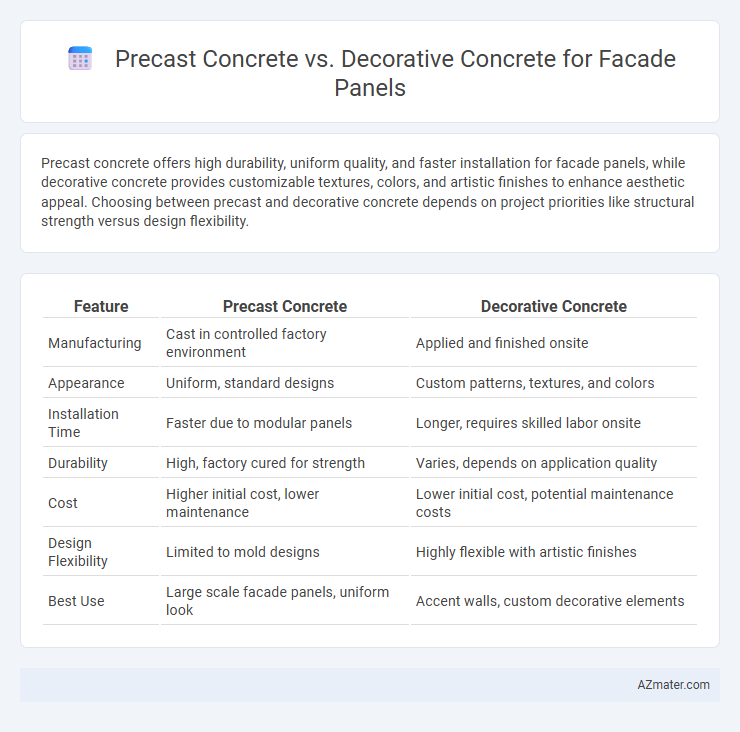Precast concrete offers high durability, uniform quality, and faster installation for facade panels, while decorative concrete provides customizable textures, colors, and artistic finishes to enhance aesthetic appeal. Choosing between precast and decorative concrete depends on project priorities like structural strength versus design flexibility.
Table of Comparison
| Feature | Precast Concrete | Decorative Concrete |
|---|---|---|
| Manufacturing | Cast in controlled factory environment | Applied and finished onsite |
| Appearance | Uniform, standard designs | Custom patterns, textures, and colors |
| Installation Time | Faster due to modular panels | Longer, requires skilled labor onsite |
| Durability | High, factory cured for strength | Varies, depends on application quality |
| Cost | Higher initial cost, lower maintenance | Lower initial cost, potential maintenance costs |
| Design Flexibility | Limited to mold designs | Highly flexible with artistic finishes |
| Best Use | Large scale facade panels, uniform look | Accent walls, custom decorative elements |
Introduction to Precast and Decorative Concrete Facade Panels
Precast concrete facade panels are factory-made, offering high durability, uniform quality, and efficient installation, ideal for large-scale construction projects requiring precise specifications. Decorative concrete facade panels provide customizable textures, colors, and patterns directly applied on-site, enhancing architectural aesthetics and allowing creative flexibility. Both methods combine structural strength with design versatility, but precast panels emphasize consistency and speed, while decorative concrete highlights unique visual appeal.
Material Composition: Precast vs Decorative Concrete
Precast concrete for facade panels consists primarily of cement, aggregates, water, and admixtures, offering high strength and durability due to controlled factory fabrication. Decorative concrete integrates similar base materials but incorporates pigments, stains, and surface treatments to achieve varied textures and aesthetic finishes. The material composition of precast concrete prioritizes structural performance, while decorative concrete emphasizes visual appeal and customization.
Manufacturing Processes Compared
Precast concrete for facade panels is produced by casting concrete in reusable molds under controlled factory conditions, allowing precise quality control, rapid curing, and consistent strength. Decorative concrete manufacturing involves onsite application techniques such as stamping, staining, or polishing, offering aesthetic versatility but requiring longer curing times and skilled labor for surface finishing. The factory-based precast process ensures uniformity and structural integrity, whereas decorative concrete emphasizes customizable textures and colors tailored to design specifications.
Design Flexibility and Customization
Precast concrete offers limited design flexibility due to standardized molds and repetitive manufacturing processes, making it suitable for large-scale projects with uniform facade panels. Decorative concrete provides extensive customization options through techniques like stamping, staining, and engraving, allowing intricate patterns and diverse textures tailored to specific architectural aesthetics. Architects and designers favor decorative concrete when unique, visually appealing facade elements are essential for enhancing a building's identity and curb appeal.
Aesthetic Appeal and Surface Finishes
Precast concrete facade panels offer uniformity and precision in surface finishes, enabling smooth, textured, or patterned aesthetics that enhance architectural consistency. Decorative concrete provides greater versatility in design, allowing for customized color stains, overlays, and intricate surface detailing that can mimic natural materials like stone or wood for unique visual appeal. Both options deliver durable, weather-resistant finishes, but decorative concrete excels in artistic expression, while precast concrete ensures repeatable, high-quality aesthetics.
Structural Performance and Durability
Precast concrete facade panels offer superior structural performance with high compressive strength and uniform load distribution, ensuring long-term stability in various environmental conditions. Decorative concrete, while enhancing aesthetic appeal through customizable textures and colors, generally lacks the same level of structural robustness and may require additional treatments to improve durability. Both materials benefit from advanced curing techniques, but precast concrete panels typically demonstrate greater resistance to wear, weathering, and chemical exposure, making them ideal for demanding structural applications.
Installation Methods and Efficiency
Precast concrete facade panels are manufactured off-site and installed using cranes and heavy machinery, allowing for faster on-site assembly and reduced labor costs. Decorative concrete, applied directly to the facade, requires skilled craftsmanship and longer curing times, which can extend installation duration. Precast panels offer higher installation efficiency with consistent quality, while decorative concrete provides greater design flexibility but demands more time and effort during application.
Cost Analysis: Precast vs Decorative Facade Panels
Precast concrete facade panels generally offer lower long-term costs due to their durability, faster installation, and reduced maintenance requirements compared to decorative concrete panels. Decorative concrete facade panels often involve higher upfront expenses related to customized designs, intricate finishes, and labor-intensive techniques. Considering lifecycle costs, precast concrete panels provide better value for large-scale projects with standardized designs, while decorative concrete suits smaller projects prioritizing aesthetic flexibility despite higher cost variability.
Sustainability and Environmental Impact
Precast concrete facade panels offer enhanced sustainability by incorporating recycled materials and reducing onsite waste through factory-controlled production, resulting in lower carbon emissions compared to traditional methods. Decorative concrete facade panels can utilize eco-friendly pigments and sealants, but their environmental impact depends heavily on the mix design and maintenance requirements over time. Choosing precast concrete supports circular economy principles via reuse and recyclability, while decorative concrete may require more frequent renovations, increasing resource consumption and environmental footprint.
Choosing the Right Concrete Panel for Your Project
Selecting the right concrete panel for your facade involves weighing durability and aesthetic appeal; precast concrete offers superior strength, consistent quality, and faster installation due to factory production, making it ideal for large-scale projects requiring uniformity. Decorative concrete panels provide versatile design options, such as textured patterns and custom colors, enhancing visual impact for architectural statements but may require more maintenance over time. Evaluating project scale, budget constraints, and desired finish are essential to determine whether the robust functionality of precast or the creative flexibility of decorative concrete best meets your facade needs.

Infographic: Precast concrete vs Decorative concrete for Facade panel
 azmater.com
azmater.com